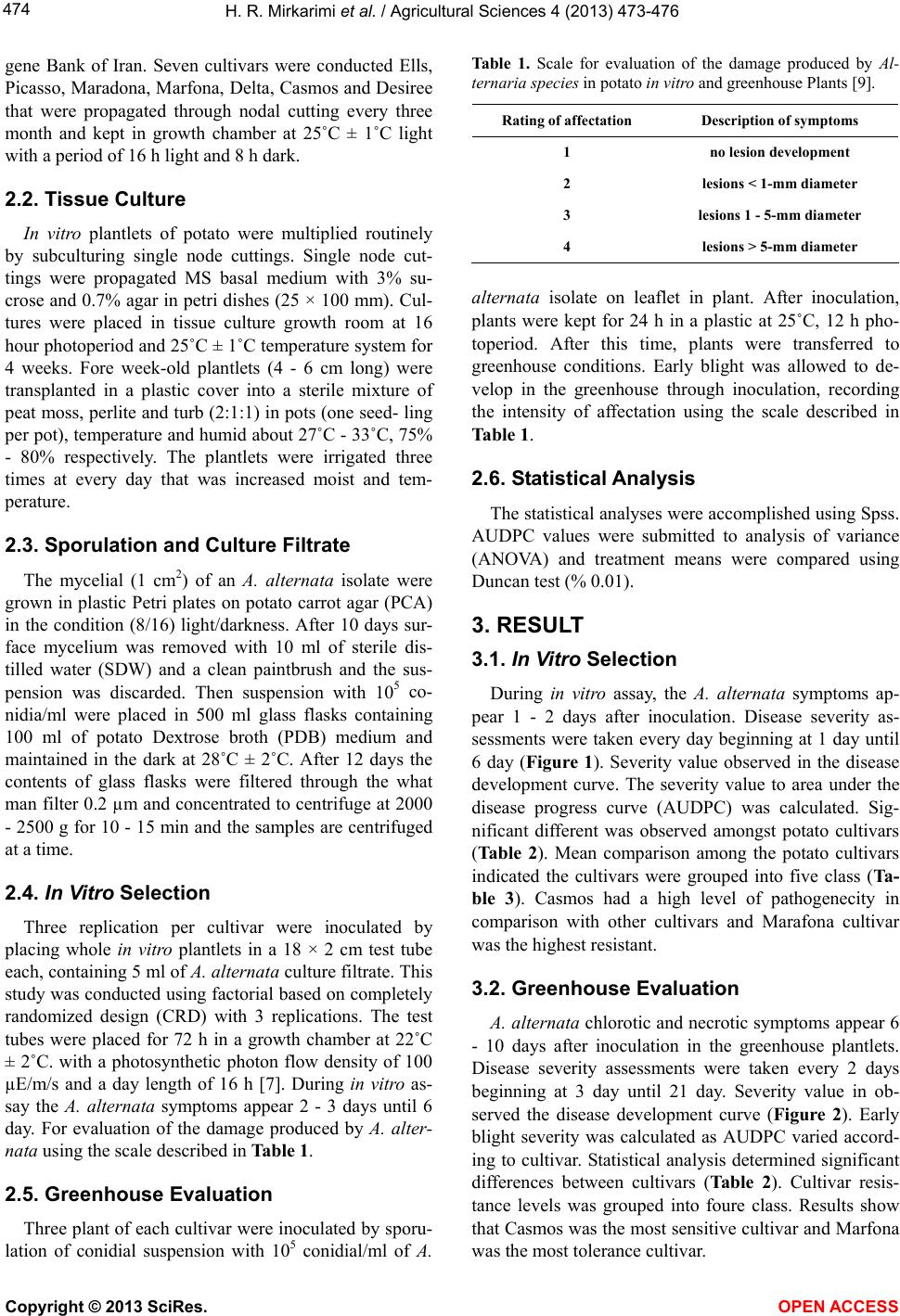
H. R. Mirkarimi et al. / Agricultural Sciences 4 (2013) 473-476
474
gene Bank of Iran. Seven cultivars were conducted Ells,
Picasso, Maradona, Marfona, Delta, Casmos and Desiree
that were propagated through nodal cutting every three
month and kept in growth chamber at 25˚C ± 1˚C light
with a period of 16 h light and 8 h dark.
2.2. Tissue Culture
In vitro plantlets of potato were multiplied routinely
by subculturing single node cuttings. Single node cut-
tings were propagated MS basal medium with 3% su-
crose and 0.7% ag ar in petri dishes (25 × 100 mm). Cul-
tures were placed in tissue culture growth room at 16
hour photoperiod and 25˚C ± 1˚C temperature system for
4 weeks. Fore week-old plantlets (4 - 6 cm long) were
transplanted in a plastic cover into a sterile mixture of
peat moss, perlite and turb (2:1:1) in pots (one seed- ling
per pot), temperature and humid about 27˚C - 33˚C, 75%
- 80% respectively. The plantlets were irrigated three
times at every day that was increased moist and tem-
perature.
2.3. Sporulation and Culture Filtrate
The mycelial (1 cm2) of an A. alternata isolate were
grown in plastic Petri plates on potato carrot agar (PCA)
in the condition (8/16) light/darkness. After 10 days sur-
face mycelium was removed with 10 ml of sterile dis-
tilled water (SDW) and a clean paintbrush and the sus-
pension was discarded. Then suspension with 105 co-
nidia/ml were placed in 500 ml glass flasks containing
100 ml of potato Dextrose broth (PDB) medium and
maintained in the dark at 28˚C ± 2˚C. After 12 days the
contents of glass flasks were filtered through the what
man filter 0.2 µm and concentrated to centrifuge at 2000
- 2500 g for 10 - 15 min and the samples are centrifuged
at a time.
2.4. In Vitro Selection
Three replication per cultivar were inoculated by
placing whole in vitro plantlets in a 18 × 2 cm test tube
each, containing 5 ml of A. alternata culture filtrate. This
study was conducted using factorial based on completely
randomized design (CRD) with 3 replications. The test
tubes were placed for 72 h in a growth chamber at 22˚C
± 2˚C. with a photosynthetic photon flow density of 100
µE/m/s and a day length of 16 h [7]. During in vitro as-
say the A. alternata symptoms appear 2 - 3 days until 6
day. For evaluation of the damage produced by A. alter-
nata using the scale described in Table 1.
2.5. Greenhouse Evaluation
Three plant of each cultivar were inoculated by sporu-
lation of conidial suspension with 105 conidial/ml of A.
Table 1. Scale for evaluation of the damage produced by Al-
ternaria species in potato in vitro and greenhouse Plants [9].
Rating of affectation Description of symptoms
1 no lesion development
2 lesions < 1-mm diameter
3 lesions 1 - 5-mm diameter
4 lesions > 5-mm diameter
alternata isolate on leaflet in plant. After inoculation,
plants were kept for 24 h in a plastic at 25˚C, 12 h pho-
toperiod. After this time, plants were transferred to
greenhouse conditions. Early blight was allowed to de-
velop in the greenhouse through inoculation, recording
the intensity of affectation using the scale described in
Table 1.
2.6. Statistical Analysis
The statistical analyses were accomplished using Spss.
AUDPC values were submitted to analysis of variance
(ANOVA) and treatment means were compared using
Duncan test (% 0.01).
3. RESULT
3.1. In Vitro Selection
During in vitro assay, the A. alternata symptoms ap-
pear 1 - 2 days after inoculation. Disease severity as-
sessments were taken every day beginning at 1 day until
6 day (Figure 1). Severity value observed in the disease
development curve. The severity value to area under the
disease progress curve (AUDPC) was calculated. Sig-
nificant different was observed amongst potato cultivars
(Ta b le 2). Mean comparison among the potato cultivars
indicated the cultivars were grouped into five class (Ta-
ble 3). Casmos had a high level of pathogenecity in
comparison with other cultivars and Marafona cultivar
was the highest resistant.
3.2. Greenhouse Evaluation
A. alternata chlorotic an d necrotic symptoms ap pear 6
- 10 days after inoculation in the greenhouse plantlets.
Disease severity assessments were taken every 2 days
beginning at 3 day until 21 day. Severity value in ob-
served the disease development curve (Figure 2). Early
blight severity was calculated as AUDPC varied accord-
ing to cultivar. Statistical analysis determined significant
differences between cultivars (Table 2). Cultivar resis-
tance levels was grouped into foure class. Results show
that Casmos was the most sensitive cultiv ar and Marfona
was the most tolerance cultivar.
Copyright © 2013 SciRes. OPEN A CCESS